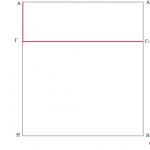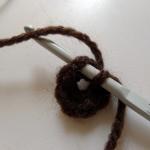How much does an empty backpack weigh? How much should a student's backpack weigh?
My child entered first grade this year. Today I decided to help carry a child, a recent preschooler, his backpack. The first thoughts that came to my mind at that moment were: how does a child carry such weights and how can this affect the child’s back?
First, I started looking for information on how much a school backpack with textbooks should weigh according to the standards. It turned out that such standards still exist and the State Sanitary and Epidemiological Service (SES) advises adherence to them. So:
1. The student’s backpack must be correct. That is, it must have a rigid orthopedic back that does not allow the child to slouch, two wide adjustable straps that prevent the child from wearing a backpack on one shoulder, and the width of a school backpack should not exceed the width of the student’s shoulders.
2. The weight of a school backpack also has its limitations: an empty backpack should not weigh more than 700 g.
3. In elementary school, the weight of the backpack with all its contents should be no more than 10% of the child’s weight, and in high school - no more than 15%. That is, if a first-grader weighs 25 kg, then the weight of his backpack should not exceed 2.5 kg.
I decided to test the last statement experimentally. My first grader still has 3 lessons a day: reading, math and writing. In his backpack he carries 2 textbooks (Primer and Mathematics), 2 notebooks of 12 sheets (checkered and oblique) and 2 copybooks (all in a notebook folder), a pencil case and pencils.

And this is what I got:

.jpg)
A backpack without everything a first-grader needs weighs a little more than 700 g. In principle, this is within the normal range. But a first-grader’s backpack filled with just the above items already weighs 2 kg 340 g. This, according to my son’s weight, is within the normal range. This is without a bottle of water and a sandwich (then all the rules are violated). But it’s also difficult to imagine how much this same backpack will weigh if my first-grader’s lessons are added and I need to take something for work or drawing.


What is the danger of overloading a school backpack?
Orthopedists assure that parents should pay attention not only to the weight, but also to the correct placement of the backpack on the child’s back: it should not hang below the shoulder blades, as this leads to excessive stress on the lower part of the spine and causes its curvature. In this case, from overload with a too heavy school backpack, not only scoliosis, but also kyphosis can occur. Also, too much weight of the backpack can lead to deformation of the shoulder joints. And if a student has flat feet (which is not so uncommon now), other problems may arise. With excessive load on the back, pressure on the student’s feet increases, which leads to pain in the hip joints, displaced intervertebral discs, back pain, and then to headaches.
Our advice!
Before sending your student to school, check his school bag. Very often there are things in the backpack that the student does not need at all at school, but at the same time they add weight to the backpack. It is also worth placing all the contents of the briefcase into its different pockets so that the load is distributed evenly and the student does not bend to the side.
SanPiN 2.4.2.2821-10 “Sanitary and epidemiological requirements for the conditions and organization of training in educational institutions” (Appendix 1), as well as in the Unified Sanitary and Epidemiological Requirements for Goods Subject to Sanitary and Epidemiological Surveillance, will help us in answering this question. noted that backpack weight without textbooks for students in grades 1-4 should be no more than 700 grams.
But this is the backpack itself, and how much it can weigh along with its contents. To answer this question, we often turned to documents on labor protection for adolescents, where Appendix No. 2 in the table of weight carrying norms indicates that for teenagers 14-15 years old it is possible to carry up to 2 kg, for 16-17 year olds - up to 3 kg.
In the same time, orthopedic standards limit the weight of a school backpack from 10 to 15% of the student’s weight. Those. if a schoolchild weighs 30 kg, then the weight of a backpack with textbooks and replacement shoes cannot exceed 4.5 kilograms. In 2010 they were approved new requirements for the weight of textbooks and writing instruments (clause 10.32). Weight of daily textbook set and writing instruments should not exceed: for students in grades 1-2 - more than 1.5 kg, grades 3-4 - more than 2 kg, grades 5-6 - more than 2.5 kg, grades 7-8 - more than 3.5 kg , 9-11 - more than 4 kg.
In reality, children carry twice as much weight. Let's take a regular sixth grade, where the set of textbooks consists of 12 books. It turns out that on average a fifth-grader's briefcase weighs six to seven kilograms, which is more than 20% of the weight of the average schoolchild.
Of all the things a student's school bag is filled with, the situation is worst with heavy textbooks. The average weight of a textbook is 600 grams, but such textbooks as “Literature” fall short of a kilogram, only 200 grams. Now it’s clear why already in the first three years school life Posture is impaired in half of the children.
According to Sanitary rules and SanPiN standards 2.4.7.1166-02 2.4.7. Hygiene of children and adolescents "Hygienic requirements for educational publications for general and primary vocational education" Ves textbook should not be more:
- 300 g for grades 1 - 4;
- 400 g for grades 5 - 6;
- 500 g for grades 7 - 9;
- 600 g for 10 - 11 grades.
But it is allowed to increase the weight of the textbook by up to 10%.
How to make life easier for your child. After all, the contents of a schoolbag affect not only your posture and spine, but also your vision. According to statistics, over the course of 5 years of study, vision declines in a third of all schoolchildren.
Parents have repeatedly raised the issue of how much a school bag should weigh and tried to force school administrations to follow the standards, but no one has canceled educational standards either, and they become a priority in this dispute. Many schools, of course, meet halfway: they make a schedule to distribute “heavy” items by day of the week, find a place in the school to store the student’s belongings, etc. But a lot depends on the parents themselves.
First, it's worth taking an inventory of the contents of your child's backpack to ensure it doesn't contain unnecessary items or textbooks that aren't required for class.
Secondly, it is possible or rather necessary to use orthopedic backpacks. As an option, you can pay attention to Randoseru school orthopedic backpacks http://randose.ru/shkolnye-ortopedicheskie-ryukzaki. In addition to orthopedic backpacks, you can purchase a briefcase on wheels, but as practice shows, it is difficult to use in winter.
What are the prospects for solving this problem?
Digital copies of textbooks will come to the rescue. We have already written that in .
The result was a high rating from 95% of teachers, who expressed the need to use such publications and fully supported the project. Only 5% of teachers did not find advantages and did not appreciate the idea of switching from paper to electronic publications.
The weight of the experimental electronic textbook does not exceed 200-500 grams. But the most important thing is that this is one device with materials for all subjects. Of course, the vast majority will give preference to just such an innovation, which offers continuous advantages. And the cost of one e-book is still in the range of 1.5-2 thousand rubles, but for many parents the child’s health will be more important.
According to statistical data, there is a sharp deterioration in the health of children in Russia.
30-35% of children entering school already have chronic diseases. Over the years of schooling, the number of children with musculoskeletal disorders increases 5 times. There are many factors that influence such health problems. Experts from the Institute of Developmental Physiology of the Russian Academy of Education claim that schoolchildren carrying heavy objects can cause not only poor posture, but even stunted growth. So how much should a student’s backpack weigh?
Student's briefcase weight
To reduce the load on the student, standards have been introduced for the weight of a student’s backpack in various classes. In order for these figures to become a reality, schools are recommended to have two sets of textbooks: one to be taken home to prepare for lessons, and the second to be kept in the classroom.
School bag weight
| Class | Maximum permissible weight of the briefcase |
| 1st-2nd | No more than 1.5 kg |
| 3-4th | No more than 2.0 kg |
| 5-6th | No more than 2.5 kg |
| 7-8th | No more than 3.5 kg |
| 9-11th | No more than 4.0 kg |
P The above material came into force on September 1, 2011 according to the decree of the Chief State Sanitary Doctor Russian Federation dated December 29, 2010 No. 189 “On approval of SanPiN 2.4.2.2821-10 “Sanitary and epidemiological requirements for the conditions and organization of training in educational institutions.”
LINK: http://www.examen.ru/add/manual/15549/ves_portfelja_shkolnika
http://msch3.ucoz.ru/load/issledovatelskaja_rabota_quot_vlijanie_vesa_rjukzaka_mladshego_shkolnika_na_sostojanie_ego_zdorovja_quot/1-1-0-8
Date: 08/26/2014.
How to choose schoolbag for a child? Advice from an orthopedic doctor
The end of summer is a busy time for parents of schoolchildren. Need to buy it in time academic year all you need. Among the many important...
A satchel or school backpack is equipped with two straps and is designed to be worn on the shoulders. In this case, the load is distributed evenly and the child’s back does not bend. Of course, classic backpacks are only suitable for students junior classes. Special school backpacks are produced for high school students. They also keep their shape well, are comfortable, safe and also look stylish.
Pockets matter
Carefully inspect the seams and fastenings - how well they are made. The lines must be double.
Check if there are any glued parts, there may be some
shouldn't
;
with a rigid, so-called orthopedic back, which forms the correct posture and prevents pressure from textbooks;
bright colors, equipped with reflective elements (reflectors). This is also the wish of the traffic police service; it is especially relevant for children who have to cross the road;
with adjustable padded straps. It is important that the straps can be adjusted not only to the height of the student, but also to the clothes (it’s one thing for a child to wear a shirt, another for a coat or fur coat). And the additional seal and sufficient width (at least 4 cm) will not allow the straps to cut into the shoulders;
with enough compartments and pockets. In modern models, in addition to standard compartments for notebooks, textbooks and pencil cases, there are compartments for mobile phone, pockets for a water bottle and a plastic lunch container. This is very convenient and will help your child find the right thing faster.
Avoid overloading
A school bag often turns into a storage place for all sorts of things that are completely unnecessary at school. From the first days, you should teach your baby to carry only the essentials with him. After all, overload leads to back problems and, as a consequence, to a number of other diseases.
The weight of the backpack with all its contents should be a maximum of 15% (and for junior schoolchildren- 10%) of the total weight of the child. So an empty backpack should weigh from 500 to 800 g, no more.
Please note the hygiene guidelines (this includes the weight of the school bag and daily study kit with writing materials) (see above):
Also make sure that the width of the backpack did not exceed the width of the child’s shoulders, the upper edge was no higher than the shoulders, and the lower edge was no lower than the hips.
And, of course, we should not forget that choosing a backpack is a joint matter. Don’t focus only on your own taste and wishes; be sure to involve your child in the process.
For a first-grader, a beautiful backpack is an additional incentive to go to school, and the concept of convenience among high school students and parents can be completely different... So you shouldn’t neglect the child’s opinion, but you shouldn’t let this process take its course. In the end, going to pick up a schoolbag or backpack can be extra time you and your student spend together.
Expert opinion
Alisa Khlebnikova, orthopedic surgeon:
When examining 7-8 year old children, I often see poor posture. Moreover, the kids whom I examined two or three years earlier did not have such a problem. It turns out that for such a short time kids manage to get into quite adult problems. This is due to the lifestyle of modern children and their school backpacks.I believe that Choosing a backpack is choosing your baby's health
.
Therefore, there is no need to save money; you should buy orthopedic backpacks (it doesn’t matter whether your child has back problems or not). And, of course, you need to teach your child how to put on a backpack correctly. It needs to be placed on the desk and both straps must be put on at the same time. You should also do relaxing exercises for your back from time to time.
LINK:
The weight of a schoolchild's backpack often exceeds the standards established by the state. A doctor and a teacher tell Letidor how to solve the problem of constant weights.
The Ministry of Education has been closely dealing with the problem of the weight of a school backpack for several years. The main idea of officials to transfer children to learning using e-books is still difficult to implement, since the technical equipment of schools is far from ideal. Because of this, parents have to get out of it: change several backpacks a year, carry carts and carry heavy weights for the child. Some people adopt the experience of foreign mothers and buy their children bags on wheels, as parents do in Israel and Spain.
How much should a backpack for a junior, middle and high school student weigh?
According to SanPiN standards, the weight of a daily set of textbooks, writing materials, as well as folders, change sheets and everything else that a schoolchild crams into a backpack should not exceed several kilograms.
Norm for different ages:
- 1st and 2nd class - no more than 1.5 kg,
- 3rd and 4th class - no more than 2 kg,
- 5th and 6th grade - no more than 2.5 kg,
- 7th and 8th grade - no more than 3.5 kg,
- 9th and 11th grades - no more than 4 kg.
However, we often don’t think that the weight of a backpack can be reduced by following three rules:
- Don't take anything extra
This is surprising, but children, especially older and high school, often carry almost the entire set of textbooks every day. Teach your child to take out unnecessary notebooks and books, art supplies that will not be useful to him on a particular day.
Also, don’t take ten extra pens and pencils.
- Once a week, clean your backpack of foreign objects
If you look into your child’s briefcase at the end of the module, you might be surprised how many foreign objects have accumulated there over the course of a month. Half-eaten chocolate, oranges, apples and juice from the school canteen... All these things make the bag significantly heavier.
- Distribute things correctly
If you put all the heaviest things at the bottom of the backpack, it will pull down, which means it will seem heavier. Distribute items evenly: the heaviest textbooks should be placed closer to the back - this will not reduce the weight, but it will make your back easier.
Doctor's opinion
Comments ** PhD, * * pediatric orthopedist-traumatologist ** European medical center **Ph.D. Irina But-Gusaim:
First of all, the backpack should be comfortable and not heavy when empty. When worn, it should fit snugly against your back - this way the load will be distributed evenly. If the backpack doesn't touch your upper back, it's bad. The backpack straps must be carefully adjusted so that the backpack ends strictly at the lower back and not at the pelvis. Explain to your child that the backpack must be worn on two shoulders. Otherwise, an imbalance begins in the muscles of the back and shoulder girdle; under the weight of the backpack, the child will begin to lean forward, which will subsequently lead to back pain.
If, after the first month of school, a child complains of back pain or the heaviness of his backpack, it is not too late to find a suitable replacement or reconsider the contents of the old one.
He talks about how to approach these issues rationally. chief physician Osteon clinic osteopath Lyudmila Butenko:
- Changing the backpack
The shape of the backpack should be rectangular and oblong, across the entire width of the back. The back of the backpack must be orthopedic, the straps are wide and connected with a special lock at the front.
- Freeing up your hands
Parents often ask what is better for their backs: carrying all their school supplies only in a backpack or unloading their briefcase and carrying physical fitness form, replacement shoes and a folder for creativity in hands. Honestly speaking, the second option is not the best idea.
It is better for your back to carry all your school supplies in a backpack without overloading your child with bags and folders. Try to fit everything you need into the backpack so that the child can support the backpack straps in front with his free hands.
- About using a bag instead of a backpack
Students in middle school refuse to wear “proper” backpacks and often opt for shoulder bags. Parents should remember that it is recommended to wear a bag instead of a backpack only in high school, when teenagers have already formed a torso. To maintain correct posture, you do not need to use a long strap and wear it on your shoulder, with your body skewed. The ideal option for carrying a bag for both children and adults is on an arm extended along the body, at the bottom, alternating the load with right hand to the left.
How much should a backpack weigh? SanPiN norms.
Discussions about the need to reduce the weight of school bags have been going on for a long time. Heavy backpacks and especially briefcases influence the formation of incorrect posture. Regular stress on a fragile spine is fraught with troubles for the rest of your life.
According to statistics, only 20% of students enter first grade completely healthy, and less than 10% leave eleventh grade. Moreover, the strongest blow falls precisely on the musculoskeletal system.
What kind of portfolio should it be to take care of your health?
Today, every fourth first grader wears a backpack that is heavier than required.
According to paragraph 2.8.1 of sanitary rules and regulations SanPiN 2.4.7//1.1.1286-03 “Hygienic requirements for clothing for children, adolescents and adults, children’s products and materials for products (products) in contact with human skin”, the weight of school briefcases (knapsacks) for students primary classes should not exceed 600 – 700 grams
. In October, new sanitary standards regarding children's clothing, as well as children's products, came into force. In particular, they regulate the weight of school bags. Rospotrebnadzor believes that school bags should become much lighter.
( Resolution of the Chief State Sanitary Doctor of the Russian Federation dated June 28, 2010 N 72 “On approval of SanPiN 2.4.7/1.1.2651-10”)
The weight of briefcases and school bags for primary school students should not exceed 600-700g, for middle and high school students - 1kg.
Satchel first grader at full load , that is, with all textbooks, notebooks and writing materials, should weigh no more than 3 kg, and the school bag of a 12-year-old student - no more than 5 kg, starting from the 10th grade - up to 6 kg. In general, the weight of a school bag can be calculated as follows: it should be no more than 10% of the child’s weight.
In theory, all notebooks, textbooks, and the like assigned for one school day should fit into the required weight. But often the child is given a second breakfast in his backpack or briefcase; some kids have not yet gotten used to their toys and take one of them with them to school, and they also have to carry a change of shoes, sports uniform etc. What can you advise in this case?
First of all, parents, buying some attributes school supplies for a small schoolchild, pay attention to their weight, so that in the total amount it weighs a little. For example, you can buy a massive pencil case made of heavy material with various beautiful, but unnecessary details, or you can buy a simple and lightweight plastic one.
Textbooks They weigh too much, making the school bags of first-graders too heavy to lift. Since 1998weight of textbooks , namely they are the main component of the portfolio, are strictly regulated by GOST"Sanitary rules and norms SanPiN 2.4.7.702-98 "Hygienic requirements for educational publications for general and primary vocational education."
In paragraph 2.4.7. “Hygiene of children and adolescents” - books for primary grades should weigh a maximum of 300 grams, textbooks for grades 5-6 - 400 grams, for grades 7-9 - 500 grams. And graduates’ portfolios should not contain books heavier than 600 grams.These parameters are also included in the quality certificates used by printing houses to print school literature.
In the hygienic requirements for the conditions of implementation of the main educational program primary general education(draft 2009) requirements establishedto the weight of an educational publication for primary school students - no more than 300 g. The weight of publications for grades 1–4, intended for work only at home or in the classroom, should not exceed 500 g. An increase in the weight of the publication by no more than 10% is allowed (access mode:http:// standard. edu. ru (official website of the Federal State Educational Standard).
Here are some SanPiN points"Hygienic requirements for educational publications for general and primary vocational education."
1.1 Sanitary rules and regulations “Hygienic requirements for educational publications for general and primary vocational education” are intended for organizations and enterprises engaged in publishing or publishing and printing activities, institutions of the state sanitary and epidemiological service and are aimed at the prevention of diseases of the visual organs, musculoskeletal system and the cardiovascular system of the body of students.
1.2 Sanitary rules establish requirements for the weight, font design and print quality of educational publications (textbooks, teaching aids, workshops - hereinafter publications), as well as requirements for printing materials used for the production of publications.
1.3 The sanitary rules apply to publications bearing the stamp of the Federal Educational Management Body of the Russian Federation or the educational management body of a constituent entity of the Russian Federation.
1.5 Responsibility for the implementation of these Sanitary Rules rests with organizations or enterprises engaged in publishing or publishing and printing activities, regardless of departmental affiliation and forms of ownership.
1.6 Monitoring the implementation of these Sanitary Rules is carried out by institutions of the state sanitary and epidemiological service.
1.8 Publications are subject to hygienic examination.
The sale of publications, including those produced abroad, is possible only in agreement with the institutions of the State Sanitary and Epidemiological Service.
Methodology for carrying out hygienic examination
1. The size of the publication block in height and width according to clause 5.1.2 is determined with a ruler with an accuracy of 1 mm.
2. The type of paper according to clauses 5.6.2, 5.6.3, 5.6.5 is determined from the information in the publication’s imprint or from the information provided about the materials.
3. The external design according to clause 5.1.5 and the fastening method according to clause 5.1.6 are determined visually.
4. Edition weight according to clause 5.1.3 determined on a scale with an accuracy of 5 g.
5. Hygienic requirements for publications
5.1 General hygiene requirements
5.1.1 It is not allowed to publish publications that include materials from two levels of education (age groups).
The publication must include materials designed for no more than:
1 year of study for 1st grade;
2 years of study for grades 2-6;
3 years of study for grades 7-11.
5.1.2 Publications are allowed in formats corresponding to Table 1 of GOST 5773-90.
The optimal formats are:
For publications of 1-3 (4) classes - 70x90/16;
For publications of grades 5-11 - 60x90/16, 84x108/32, 60x84/16.
For workbooks, atlases, manuals on drawing, fine arts, labor training, etc. format 70x108/16 is allowed.
5.1.3 The weight of the publication should not exceed:
300 g for grades 1-3 (4);
400 g for grades 5-6;
500 g for grades 7-9;
600 g for 10-11 grades.
The weight of publications for classes 1-3 (4), intended for use only in class * (2), should not exceed 500 g.
It is allowed to increase the weight of the publication by no more than 10%.
5.1.4 Publications can be made in soft cover or hard cover.
5.1.5 Editions with paper-covered covers must be finished by pressing film.
Editions with covers must be finished by varnishing or pressing film, except for covers made of coated papers or papers with a special coating.
There are several ways to reduce the weight of school bags and thus contribute to the prevention of orthopedic and cardiovascular diseases in students: (Booklet)
use only those textbooks and manuals that have passed a hygienic examination;
find an opportunity (in primary school) use two sets of textbooks (one at school and one at home);
when drawing up a schedule, take into account hygienic requirements for the weight of daily training kits;
organize storage of replacement shoes, sports equipment, supplies for labor lessons, visual arts and so on. on school premises;
organize a library of necessary books for additional reading in the classroom.
do not carry too much in backpacks
check your backpack daily, don’t forget to take out unnecessary textbooks.
Parents should choose a backpack very carefully. Its shape should be ergonomic and correspond to the physiological shape of the child’s spine. The length of the belts must be adjustable.
Parents of primary school students should check the backpack daily - perhaps they are carrying a lot of unnecessary things that add weight to the backpack.
Parents can purchase a second set of textbooks to keep in the classroom. An extra set of textbooks allows you to have one textbook at home for homework and another at school for class. However, this method is accompanied by large financial expenses, which not every family can afford today.
There is, of course, an optimal solution to the problem “ excess weight» portfolio: with the introduction of Federal State Educational StandardsIIgeneration, new textbooks have appeared - electronic ones, work with which requires the presence of a personal computer not only at home, but also at school.
Some educational publishers have begun to split textbooks into several parts.
In the meantime, the project is approved at the state level, only parents can take care of the health of their children, from a carefully selected backpack to daily viewing of their contents.






